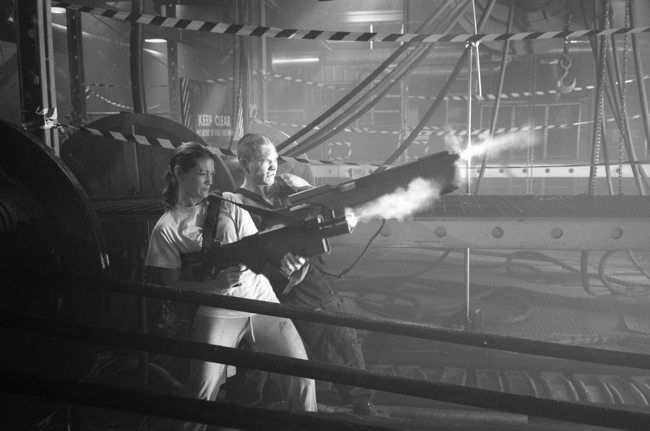Techy Film Stuff: Arriflex Cameras and Gas Guns on Death Machine |
 Ely Pouget and Martin McDougall open up with some spiffy Chaank weaponry on Death Machine , 1993. The muzzle flashes are simple burning propane - a gas bottle, much like those in your caravan, are placed just out of shot.
Death Machine
was, as mentioned previously, a Cyberpunk horror flick I worked on in Pinewood in 1993. It was almost all studio based, had a tiny budget, and was directed by Steve Norrington, latterly of Blade
and League of Extraordinary Gentleman. Norrington had a very clear sense of vision for the movie, and was a fine artist - I still have a copy of his personally sketched storyboards, and they are quite excellent. There was a certain bold panache to what he wanted to achieve, although the budget wasn't nearly big enough to fully realise what he wanted to do, hence some frustrations on set. Simply put, the 'Death Machine' of the title was a robotic military killing machine designed by the carton-strip-onomatopoeic-derived 'Chaank' corporation - which then runs riot while a small band of truth warriors infiltrate the Weapons Company. Norrington liked mechanical effects so we had several robotic Death Machines that could do various things, all to be filmed in-camera as we were still before the days of CGI. We also did back projection with Technical Oscar Winner Charlie Staffell (more on him later) and all sorts of other effects which were great fun to achieve. Norrington had a good standing within the model and mechanical effects community within the industry, so we actually had a lot more production value than the limited budget would suggest. The Chaank weaponry was something with which the art and props department spent a goodly amount of effort and the comedically large weapons you see above were just two of a veritable arsenal. Most were dummies but these two were fully practical. It would, of course, be prohibitively expensive not to say legally complex to use the action from a real automatic weapon, so the flashes you see here are simply propane, ignited by a spark at the muzzle: essentially a gas hob turned off and on really quick. The igniter is designed so you could vary the fire speed, and the sound would be laid over afterwards. In reality, a gas gun goes 'putt-putt-putt-putt-putt' ++ Semi-complex techie dry film stuff alert ++ So all well and good, but when we were testing them on film early on in the movie, I had an idea: Surely it would be possible to synchronise the igniter to the camera shutter so the flashes gave a consistent burst of flame? The perennial problem with photographing automatic weapons is that the flashes are shorter than the 1/50th sec the shutter is typically running at, so any flash that occurs when the shutter is closed.... Okay, let's go back a ways. The usual shutter mechanism on a film movie camera is a rotating semi- circular mirror in the light path behind the lens. When the mirror rotates it will direct the light to the film and the viewfinder alternatively, and at the film transport speed - usually 25 frames per second. So when the mirror is directing light to the eyepiece, the film transport mechanism is busy pulling the film down to the next frame, and when the mirror uncovers the film to take the exposure, the viewfinder will go momentarily dark - leading to a flicker seen in the eyepiece. So an automatic weapon running sporadically and with flashes faster than 1/50th may not all appear on the film. In fact, if you're seeing a lot of them through the viewfinder, then very few will appear on film. A good take of an automatic weapon will show little or no flashes through the eyepiece. Right, so I get chatting to the SPFX technician - I don't recall his name, but he was not only a Top Johnny, but also willing to give anything a go - and I told him that the accessory jack that comes out of the back of an Arriflex BLIV, the camera we were using, had a terminal to allow for synchronisation of multiple cameras. This got him interested and we took it to Norrington who said, yes, have a go, but don't let it hold anything up and it shouldn't cost anything. So that's what we did. I spoke to the boffins at the rental company Joe Dunton's who had their technicians fax me an explanation of how they think it might work and a schematic of the insides of the camera. The SPFX technician then built a small gadget that would take the timing mechanism of the igniter directly from the Arriflex and a few weeks later we tested it, and it worked - and that's what you see on film. When the actors carried the weapon there were two leads coming out the handle and secreted behind them - one to a Propane gas bottle and the other to the back of the camera. I read later that we were not the first film to do this, and given that most cameras now used are digital, the problem might not be there at all. But it was a good technical challenge, and that unnamed SPFX technician was the true brains behind the effort - I can only hope he used the knowledge gained on other movies. Recalled 28th May 2020 |